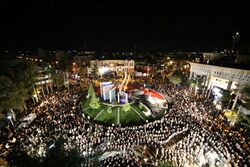Ilam, Iran
Topic: Place
 From HandWiki - Reading time: 4 min
From HandWiki - Reading time: 4 min
Ilam ئیلام Îlam | |
|---|---|
City | |
 A square in Ilam | |
 Location in the Ilam province | |
| Lua error in Module:Location_map at line 522: Unable to find the specified location map definition: "Module:Location map/data/Ilam Iran" does not exist. | |
| Coordinates: [ ⚑ ] : 33°38′06″N 46°24′26″E / 33.635°N 46.40722°E | |
| Country | Iran |
| Province | Ilam |
| County | Ilam |
| District | Central |
| Government | |
| • Mayor | Afshin Mozaffari |
| Elevation | 1,427 m (4,682 ft) |
| Population (2016)[1] | |
| • Total | 194,030 |
| Time zone | UTC+3:30 (IRST) |
| Area code(s) | 0843 |
| Climate | Csa |
| Website | www |
Ilam (Persian: ![]() ایلام, romanized: Īlām; Kurdish: ئیلام, romanized: Îlam)[2] is a Kurdish city in the Central District of Ilam County, Ilam province, Iran, and serves as the capital of the province, county and district. The Kabir Kuh mountain range lies east of the city. To the west, it borders Iraq.
ایلام, romanized: Īlām; Kurdish: ئیلام, romanized: Îlam)[2] is a Kurdish city in the Central District of Ilam County, Ilam province, Iran, and serves as the capital of the province, county and district. The Kabir Kuh mountain range lies east of the city. To the west, it borders Iraq.
Demographics
At the 2006 National Census, Ilam's population was 155,289 in 34,549 households.[3] The following census in 2011 counted 172,213 people in 42,613 households.[4] The latest census in 2016 showed the population had risen to 194,030 people in 53,581 households.[1]
Language composition:[5]
Architecture
Like many other regions of Iran the architecture in Ilam includes traditional and contemporary periods. Although easy access to fossil fuels and electricity may have aided the transition in Iranian architecture in other regions of Iran from its traditional to modern styles, in Ilam the increasing population has also played a role.
The Governor Castle, Falahaty Mansion and The Mirgholam Castle are examples of some surviving traditional buildings in Ilam. The courtyard dwelling is the main type of the buildings of this period. This type of building was accepted as the main building type over all Iran for both climatic and cultural reasons. Brick is the main constructional material in these buildings. The passive thermal techniques indicated for the Iranian traditional buildings are commonly used in these buildings.
The Governor Castle of Ilam was built in type of courtyard. Adding shade and moisture by using green landscape, high trees and a pond, were the main passive techniques used in this building to reduce the temperature in summer. The Mirgholam Castle of Ilam presents a classic Iranian courtyard. The garden and the pound were the main elements of this type of buildings. The Falahaty Mansion used a pitched roof as it was regular beside the flat roofs in the traditional buildings in Ilam earlier.[6]
Climate
Ilam is situated in the cold mountainous region of Iran at a height of 1,319 metres (4,330 ft) above mean sea level. It is located in the west of Iran at a latitude of 33° 38´ north and longitude of 46° 26´ east. Although this city is surrounded by mountains, its climate is also affected by deserts from the west and the south. This region presents a highly variable annual weather profile. Heavy showers or snow in the winter and dusty, brutally hot, dry weather in the summer are normal for this region.[7] Monthly rainfalls have been as high as 352.1 millimetres (13.86 in) in March 1974, whilst daily rainfalls have reached 86 millimetres or 3.39 inches on 26 February 1991. Temperatures have ranged from a high of 47.0 °C or 116.6 °F on 20 August 1975 to a low of −15.0 °C or 5.0 °F on 5 February 1974.
Ilam's climate is classed under the Köppen climate classification as a Mediterranean climate (Csa) with continental influences. Script error: No such module "weather box".
Script error: No such module "weather box".
Colleges and universities
Ilam contains the following universities:
- Ilam University of Medical Sciences[11]
- University of Ilam[12]
- Islamic Azad University of Ilam[13]
- Safir Danesh
- Farhangian University, Shahid Modares Campus of Ilam (Men) and Imam Jafar -e- Sadiqh Campus of Ilam (Women)
See also
- Eyvan
References
- ↑ 1.0 1.1 "Census of the Islamic Republic of Iran, 1395 (2016)" (in fa) (Excel). The Statistical Center of Iran. p. 16. https://www.amar.org.ir/Portals/0/census/1395/results/abadi/CN95_HouseholdPopulationVillage_16.xlsx.
- ↑ Ilam, Iran can be found at GEOnet Names Server, at this link, by opening the Advanced Search box, entering "-3067203" in the "Unique Feature Id" form, and clicking on "Search Database".
- ↑ "Census of the Islamic Republic of Iran, 1385 (2006)" (in fa) (Excel). The Statistical Center of Iran. p. 16. http://www.amar.org.ir/DesktopModules/FTPManager/upload/upload2360/newjkh/newjkh/16.xls.
- ↑ "Census of the Islamic Republic of Iran, 1390 (2011)" (in fa) (Excel). The Statistical Center of Iran. p. 16. https://irandataportal.syr.edu/wp-content/uploads/Ilam.xls.
- ↑ "Language distribution: Ilam Province". http://iranatlas.net/index.html?module=module.language-distribution.ilam#eyJ0IjoieCIsImkiOiI5MTIyOTFmNDM3Yjg4NzkxNThkOTQ2ZTNhNjQwOTkyZCIsInMiOjE2Mjk3Mjc3MDcwNTZ9.
- ↑ J Khodakarami. Achieving Thermal Comfort in Iranian Hospitals. Cardiff University, PhD Thesis, 2008
- ↑ J Khodakarami and I Knight. Required and Current Thermal Conditions for Occupants in Iranian Hospitals. HVAC&R Research, Vol. 14, Number 2, March 2008, pp 175-194
- ↑ "World Meteorological Organization Climate Normals for 1991-2020: Ilam". NOAA. https://www.nodc.noaa.gov/archive/arc0216/0253808/2.2/data/0-data/Region-2-WMO-Normals-9120/Iran/CSV/Ilam_40780.csv.
- ↑ "FORM 1: STATION ILAM". Iranian Meteorological Organization. http://www.irimo.ir/english/statistics/climanormals/ilam/ILAM.txt.
- ↑ "FORM 1: STATION ILAM". Iranian Meteorological Organization. http://www.irimo.ir/english/statistics/climanormals/ilam/ILAM.txt.
- ↑ "Ilam University of Medical Sciences". Ilam University of Medical Sciences. https://www.medilam.ac.ir/.
- ↑ "Ilam University". Ilam University. https://www.ilam.ac.ir/.
- ↑ "Ilam University". Ilam University. https://www.ilam.ac.ir/.
External links
- Farshid Sāmāni, Ilam, the Sleeping Beauty, in Persian, Jadid Online, 26 May 2009: [1].
• Discovering Ilam, in English, Jadid Online, 22 October 2009, [2].
• Photo gallery, containing 25 photographs with informative captions in English: [3].
 |
 KSF
KSF